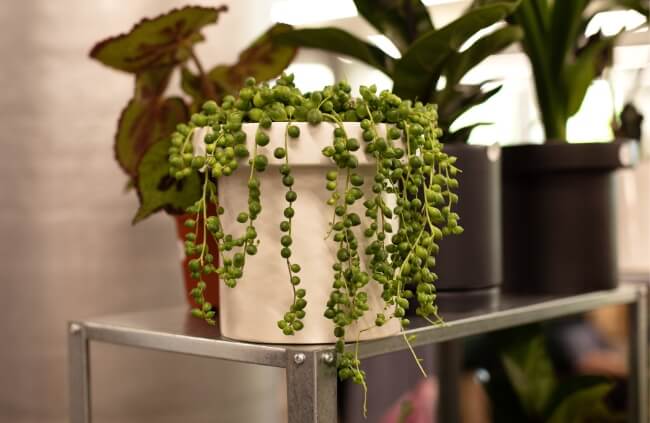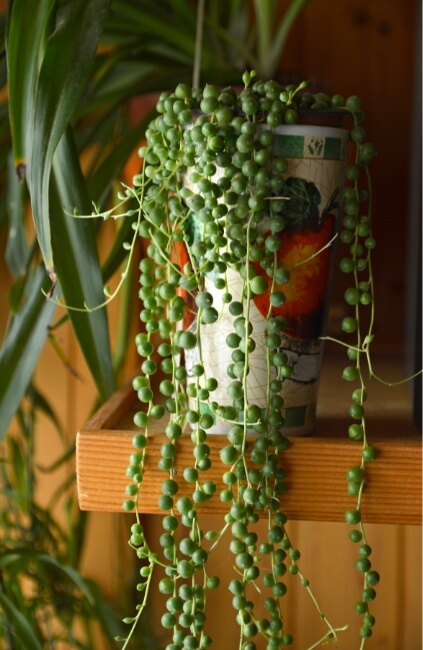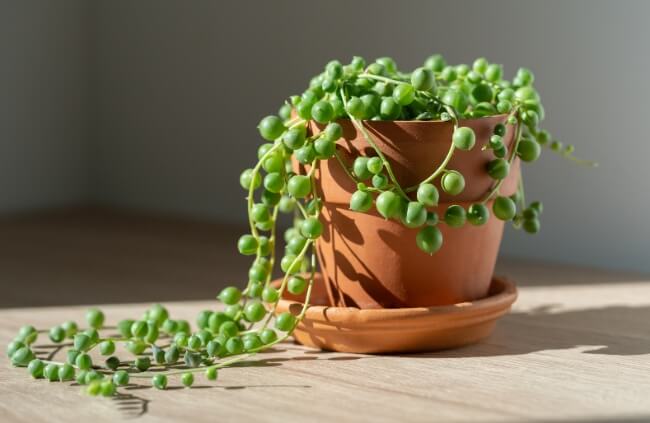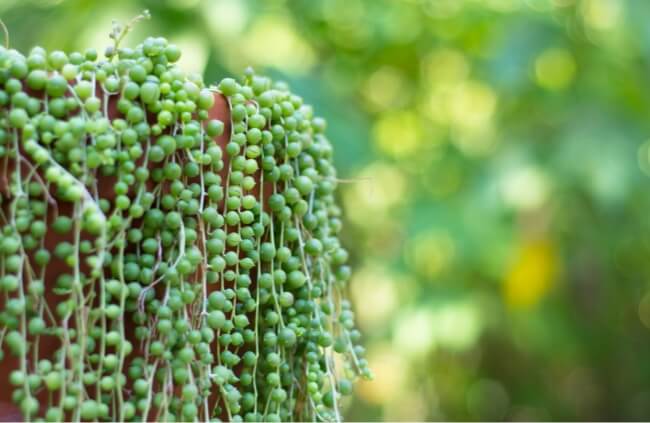String of pearls is, if you get it right, one of the most spectacular house plants you can grow. Globe-shaped succulent leaves develop alternately down fine vining stems, producing the most unique trailing effect in pretty much any situation.
While this succulent might seem, on paper, to be pretty easy-going, it’s one of the pickiest houseplants I’ve ever grown. However, once you find the right spot, it really will thrive. So, to unlock the secrets of these elegant trailing succulents, read on.
More...

Family: | Asteraceae |
|---|---|
Genus: | Curio (formerly Senecio) |
Species: | C. rowleyanus |
Origin: | South Africa |
Common Names: | String of Pearls, String of Beads |
Location: | Indoor or Outdoor |
Type: | Succulent |
Growth: | 90 cm, trailing |
Sun requirements: | Bright, indirect light |
Foliage Colour: | Green |
Flower Colour: | White |
Flowering: | Summer |
Edible Parts: | None |
Maintenance level: | Medium |
Poisonous for pets: | Toxic to cats and dogs |
What is a String of Pearls Plant?
String of pearls, or string of beads, is the common name for Curio rowleyanus. While the genus, Curio, is fairly large, this is the only plant known to grow in these conditions and with this habit, no doubt adding to its appeal as a decorative house plant.
Curio is a genus in its own right, but Curio rowleyanus was formerly classified as Senecio rowleyanus. As with all plant reclassifications, it doesn’t change how you grow it, and if you still want to call our Curio a Senecio, no one’s going to jump out and fine you.
Regardless of name, this curious Curio is easy to identify. Its globe-shaped leaves have delicate pointed tips, and grow in even alternations along long thin stems, which can reach up to 2 m long (though typically grow to about 50 cm in pots).
Its fine roots are not great in damp conditions, but it can cope with some humidity. Basically, it’s a succulent, so treat it like one!

Curio rowleyanus Natural Habitat
Curio rowleyanus, better known as String of Pearls, is native to southern and eastern South Africa, with a wide distribution through the Cape Provinces. The climate here is distinct and notable for a mixture of cold, wet winters and exceptionally dry summers.
All year round, the area is subject to harsh winds, offering a clue to how and why these unusual plants developed. Because they look so wonderful as trailing plants, which makes the most of their fascinating forms, nearly everybody grows String of Pearls in hanging pots or draped from shelves.
However, in nature, due to the high winds of the Cape Provinces, String of Pearls is actually a ground cover plant. Its roots from the leaf join along its stem, propagating itself as it goes, and would almost definitely perish in nature if grown above ground level.
How to Grow String of Pearls
In nature, string of pearls prefers to trail along the ground, but in reality, in our homes, no one can afford that sort of space, so finding a spot with the right balance of brightness, humidity, and heat (including seasonal change) is a little trickier.
The basic rules to live by with string of pearls are mild humidity, with some ventilation; free-draining soil with sparse but generous watering; and bright indirect light. Provided you give it that, your string of pearls will thrive.
Growing String of Pearls Indoors
What Soil to Use
String of pearls needs a good free-draining compost with some base nutrients, but it’s not particularly fussy about ongoing feeding. We use a cactus potting mix for string of pearls, which has a great mix of organic matter and grit to aid with drainage.
If you want to make your own mix for string of pearls, use about 60% compost with 40% either perlite or grit. Adding some crushed bark will help to keep the soil aerated too.
Pot Size
String of pearls have fine shallow roots, so they don’t need particularly big pots, but when you bring a new plant home, lift it from the pot and check how well the roots fit in its current pot.


Get Your Free Guide:
Master Growing Australian Natives eBook
A Must Have Complete Guide for Every Australian Garden
Get Your Free Guide:
Master Growing Australian Natives eBook
A Must Have Complete Guide for Every Australian Garden
Sometimes, young string of pearls are sold before they are fully rooted, and it may actually be worth planting them down to a smaller container to reduce the risk of damp compost causing rot.
Watering String of Pearls
Water string of pearls when the soil dries out. Not before, and not too long after. More than any other part of their care, watering can trigger a rapid decline in the health of string of pearls.
Overwatering can quickly harm the fine roots, and under-watering will cause leaf drop (overwatering, once root rot sets in, has the same symptoms, but the difference will be obvious if the soil is wet or dry).
In a bright, warm spot, water string of pearls fortnightly in summer. Reduce that to once a month in spring and autumn, and avoid watering altogether in winter unless it has active signs of growth.
Light & Temperature
String of pearls grows best in bright but indirect light, so choose a spot that’s about 1 m away from a bright window. If you have a warm east or west-facing window, that should offer roughly the right conditions too.
Don’t worry too much about the cold winter. Your string of pearls might look unhappy, but leave it un-watered and it will burst back into life in spring. Ideal summer temperatures are 18°C and above.
Humidity and Ventilation
You can quite easily balance excessive heat with slightly more humid conditions, and better ventilation will help to maintain a more regular watering routine.
Our string of pearls grows in a warm North-facing conservatory, but with shade from a Devil’s Ivy that covers the ceiling. The space gets incredibly warm so we place trays of pebbles filled with water beneath all the plants and keep the windows cracked through summer.
This seems to offer just the right balance of light humidity without the room becoming stuffy.
How to Grow String of Pearls Outdoors

String of pearls (Curio rowleyanus) is native to South Africa, where it grows through bright, warm summers and cool Mediterranean winters. If you want to be creative with your planting, you can actually grow it quite well outdoors in most parts of Australia.
Allow it to trail naturally as a ground cover in bright areas of the garden, and make sure it’s given regular general-purpose feeds with organic liquid fertilisers like liquid seaweed to mimic organic decomposition.
Provided it doesn’t get too dry in summer, or too damp in autumn, string of pearls makes an interesting addition to rockeries, or spilling over walls in many Australian gardens.
String of Pearls Propagation
String of pearls can be propagated in a couple of ways, including from seed – but it’s generally rare to find seeds for sale, and quite unlikely that they will flower as houseplants (you’re lucky if they do though, because their flowers are truly fascinating little white fireworks).
Propagation from cuttings, and by simply layering your plants into new compost are much easier ways to create a new string of pearl plants, and the results are quite rapid.
Layering String of Pearls
Layering might be slower than taking cuttings because your string of pearls will be stressed into producing roots in the other method, but it is much more reliable.
Essentially, you’re trying to mimic nature, by offering string of pearls vines somewhere to root into. They naturally want to produce new plants this way, so all you need is a pot, a hook, some compost and a short piece of garden wire.
To prepare your string of pearls for layering:
- Fill a small plastic pot with moisture-retentive compost.
- Hook that pot beneath your string of pearls, or place it next to the main pot.
- Using a bent piece of garden wire, pin a vine into the new compost, making sure it stays attached to the parent plant.
- After about three or four weeks, the pinned section should have rooted into the compost (tug gently to test).
- Cut it away from the parent plant, and wrap the rest of the vine over the surface of the compost.
- This will produce a really healthy new string of pearls plant in about 6 weeks.

Propagating String of Pearls from Cuttings
If your string of pearls is in pride of place, it might not be that appealing to leave pots of compost dangling beneath it. Thankfully, taking cuttings is almost as successful as layering your succulent vines, and a little bit simpler at that.
To take string of pearls cuttings, you’ll need:
- Misting bottle
- Compost
- Small plastic pot
- Scissors
And then the method is really straightforward:
- Fill a small plastic pot with any good compost (moisture retention is useful at this point, so don’t add grit or perlite).
- Snip off a 10-20 cm section of string of pearl vine.
- Wrap it around so the entire vine has good contact with the soil.
- Mist it, and leave it somewhere warm and bright, but away from direct sunlight.
- Mist regularly to prevent the soil from drying out for about two weeks.
- Gently tug on the vine to check if it has rooted into the soil – it is usually a quick process, giving new vigorous plants in a matter of weeks.
Caring for String of Pearls
If you’ve found the right position for your string of pearls plants, ongoing care is incredibly simple, but do keep a regular eye on the condition of the vines and leaves, particularly around the base of the plant, which will be the first to show signs of any growing problems.

String of Pearls Fertiliser
String of pearls doesn’t take much in the way of fertiliser, but as any house plant grower knows, the compost will lose its nutrients eventually, and the easiest way to top them up without repotting is with regular liquid fertilisers.
Any cacti and succulent feed will work, given with every other water from spring through to mid-autumn.
Pruning String of Pearls
To keep string of pearls looking good, regular pruning is actually quite useful. For most vining succulents I’d advise against it, but cutting back in spring, even right to the base, can completely reinvigorate string of pearls.
However, they grow about 20 cm per year, so if you want to maintain a large, lush plant, feed it and pinch out any damaged or diseased sections regularly, and wrap one of two vines back up to the top of the plant every year.
By wrapping vines back into the compost, you encourage fresh roots, and fresh growth, which will stop the top of your plant from looking bare.
Repotting String of pearls
String of pearls doesn’t need repotting often. We’ve had the same vigorous string of pearls planted in the same hanging pot for nearly ten years now.
Rather than changing the pot, we lift the root ball out of its container and gently shake it each year, adding fresh compost to the base and sides of the pot. Then, by wrapping a couple of vines back to the new compost, you can keep a large plant looking really healthy in the same container without repotting.
String of Pearls Pests and Diseases
Like all succulents, string of pearls are very susceptible to sap-sucking insects. As a result, it isn’t uncommon to find dieback along individual stems, or spots of yellowing or orange foliage where the insects have fed and passed disease from other plants.
More common than any of that though, is managing moisture levels, as over or under-watered string of pearls will share common symptoms, and both can open the door for diseases.
There are no pests that are unique to string of pearls, but many that seem to love it. Aphids, fungus gnats, scale, mealybugs, thrips and whiteflies are all common sights on over-watered or overfed string of pearls plants.
Spider mites can occur on under-watered string of pearls, but are simple to get rid of with an occasional soak.
For the rest, allow your plant to dry out, and rather than water at the top, water from the base of the pot. Use a watertight outer pot, with a plastic container set into it, so you can add water to the bottom of your string of pearls. This will discourage pests that lay in damp surface soil.
If the problems persist, use a neem oil spray to deal with pests on houseplants, and prevent recurrence.
Root rot is the most common cause of death for an indoor string of pearls plants. It’s caused by over watering, or poorly drained soil, particularly with plants in poor light.
If you are concerned about how long your string of pearls compost is staying moist, move it to a brighter spot, with more sun, and warmer conditions to aid evaporation, and if you can, change the soil to a more free-draining mix.
In very humid conditions, or following a pest infestation, leaf rot can affect sections of string of pearls, causing brown and dying vines. The first treatment is to remove the damaged growth before it affects anything around it. Then, find the cause.
The cause is likely to be poor ventilation, which will allow excess humidity to sit around the leaves.
Frequently Asked Questions About String of Pearls

Is string of pearls hard to keep?
String of pearls isn’t hard to keep, but it is hard to get settled in. Finding the right spot can take some trial and error, but once your string of pearls is happy in its new home, it is a fairly easy-going houseplant.
How long do string of pearls plants last?
String of pearls is a long-lived perennial plant. In the right conditions, it will continue growing happily for many years. Even if the original plant dies back, vines can be used to revive it through cuttings and layering.
What does an overwatered string of pearls look like?
An overwatered string of pearls plant will look dreary at first, with leaves not holding their usual plump form. If root rot sets in, damage can show in unusual patterns, sometimes with just one section of the plant dying back.
Can I water string of pearls with tap water?
You can water string of pearls with tap water. If you have particularly hard water in your area, run it through a filter, or use rainwater. Like all plants, string of pearls prefers fresh rainwater when possible, but it won’t kick up a fuss with tap water.
Can you split a string of pearls plant?
String of pearls can be split by teasing apart the roots, but as they have fairly fibrous, temperamental root systems, it's best to use a process of layering or cuttings for propagation, as teasing apart can be quite damaging to string of pearls.
Why are my string of pearls growing upwards?
String of pearls will initially grow upwards when they root into new compost. So any vines that accidentally root in the original container will show unexpected upward growth, before drooping back down.
Occasionally, in humid rooms, string of pearls can produce roots along hanging vines into the air. They will produce short upright vines. Cut the vine off above the rooted point and plant it for a new plant.
Can you propagate string of pearls from a single leaf?
It is possible to propagate string of pearls from a single leaf, but you’ll always have more success if you use a full vine for your cuttings. Leaves will need to have a small section of node still attached for best results if you want to try cuttings this way.
Looking for more types of string plants to add to your collection? Check out our compilation of popular string plants to grow in your home.
Wrapping Up Our Guide to Growing and Caring for String of Pearls
String of pearls, Curio rowleyanus, will probably always be popular. Its appeal is wide-reaching, and the sense of pride when you get it just right is really quite special for any gardener. Their reputation for being tricky to grow is perhaps a little unfair but come back to this guide for pointers if you ever need them.
Find the right spot, and listen to your plants. It’s a rule for every plant under the sun, but essential to live by if you want to grow string of pearls.
Published on November 2, 2023 by Maisie Blevins
Last Updated on September 20, 2024




